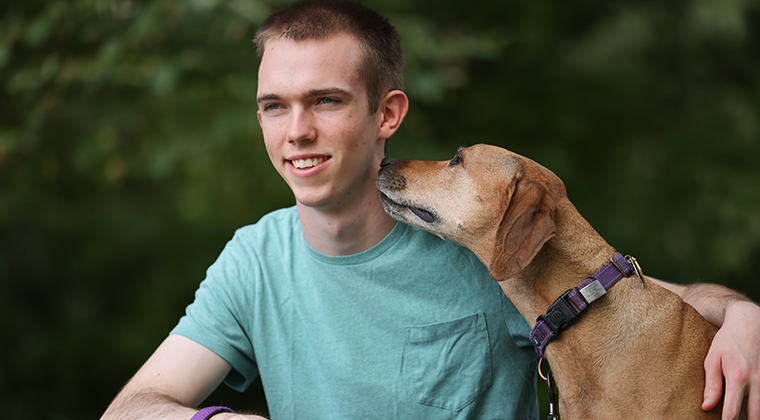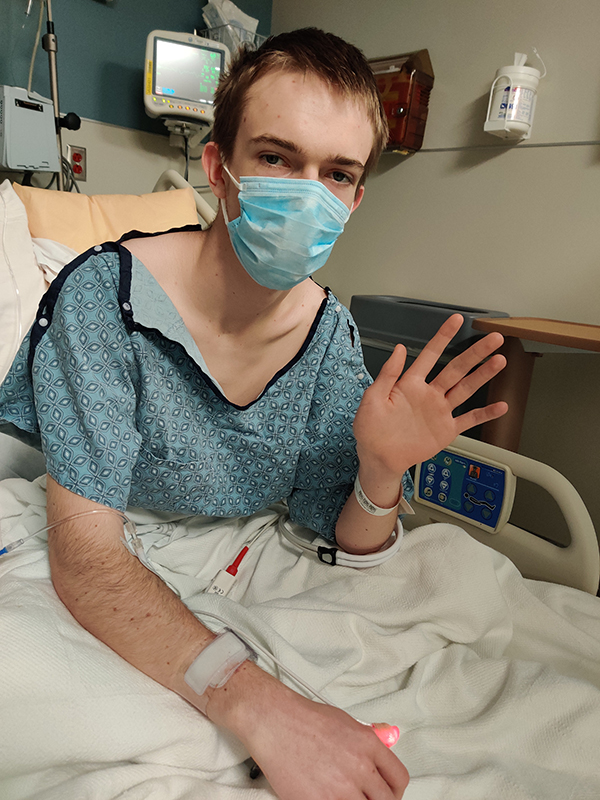
A Lifesaving Journey
With teamwork, persistent medical team saves teen's life
By Vicki Frye
Photography by Ken Huth
Published as part of the Winter 2022 issue of Duke Children's Stories
Spring is an exciting season for high school seniors—a time to make college decisions, prom plans and prepare for graduation, with all its pomp and circumstance. This was certainly true for 17-year-old Phillip Jordan, a hopeful senior at Hillside New Tech in Durham, NC. Phillip, a hard worker at a favorite local fast-food restaurant, was accepted and on his way to Virginia Tech in the fall. His parents, Wesley and Molly, were proud, thrilled to see their son’s future beginning to unfold.
Like so many others in March 2021, Phillip chose to protect his health by receiving a COVID-19 vaccination. Hours later, he was hit with a severe headache; as a family they quickly dismissed it, assuming it was a passing side effect from the recent vaccine (since headaches were out of the ordinary for Phillip). The pain became unrelenting for the next 10 days. Little did Phillip and his family know, that the headaches were much more than a side effect and ultimately would take Phillip on a journey that would save his life.
DISMISSING THE RED HERRING
At their wits’ end and hoping to find relief for their son’s pain, the Jordans followed the recommendation of their Duke primary care provider and took Phillip to the Duke University Hospital Emergency Room. It was there they met Neel Subramanian, MD, assistant professor of pediatrics and the attending pediatric emergency physician that day.
After a thorough examination and a battery of tests with “unremarkable” results, a curious Subramanian was uncomfortable at the thought of discharging his patient. Determined to find answers that would bring relief, Subramanian chose to pause and take time to talk with the Jordans in hopes of more thoroughly understanding the situation. A decision that likely saved Phillip’s life.
“As parents often are, the Jordans were Phillip’s strongest advocates. They believed his condition was more than a side effect,” shared Subramanian. “They sought to identify a clear path forward. So together, we reviewed his medical history and recent activities. Aside from his debilitating headache and some lower back discomfort, everything seemed normal, yet Phillip’s condition was continuing to deteriorate.”
With no obvious clues as to the true source of his patient’s pain and no history of headaches for Phillip, Subramanian “trusted his gut” and years of medical training and ordered an MRI. The results were staggering. The test showed that inside Phillip’s brain was a large arteriovenous malformation (AVM).
An AVM is a tangle of abnormal blood vessels connecting arteries and veins in the brain which can disrupt the normal blood flow between a patient’s heart and brain. As is common with AVMs, Phillip had likely had the malformation, undetected, since birth; but over time, it had grown and appeared to have recently hemorrhaged, causing his extreme pain and putting his life in danger. Subramanian’s decision to dig deeper before releasing Phillip prevented a potentially
catastrophic outcome.

“We were thankful to have had the best of both worlds—highly-skilled neurosurgeons and ICU medical care team, who were also understanding of us as parents.”
PASSING THE BATON
Quickly following Phillip’s diagnosis, vascular neurosurgeon and associate professor of neurosurgery at Duke, Erik Hauck, MD, who specializes in the treatment of AVMs, took the reins to lead the definitive care team. In order to gain visibility to the full scope of Phillip’s AVM, Hauck and Herbert Fuchs, MD, beloved Duke pediatric neurosurgeon and professor of neurosurgery, agreed that an angiogram was necessary. This procedure revealed that Phillip’s surgery would be complex. The mass of tangled blood vessels extended from the surface of his brain deep into his left ventricle, one of the fluid-filled cavities in the brain. Together, they explained the urgency of Phillip’s condition—the size and location of the AVM—to the Jordans, then admitted and closely monitored him, scheduling surgery within 36 hours of the diagnosis.
“It’s common for people to live their entire lives without ever knowing they have an AVM; they are unaware that they have a genetic predisposition,” remarked Hauck. “It’s not until they experience a seizure, stroke, or an incident such as the onset of headaches, like what Phillip suffered from, that they discover there’s a problem.”
As a team, Hauck and Fuchs led the more than six-hour surgery to remove Phillip’s AVM. After nearly two-thirds of the mass was taken out, what remained began to bleed from its deepest section, a risk the Jordans were aware of. The doctors were quickly able to stop the bleeding and effectively complete the removal of the AVM. In the process, there was swelling of the brain, which required Hauck to perform a craniotomy—removing part of Phillip’s skull. This bone was carefully preserved in order to return it as part of the healing process once the swelling had reduced.
All in all the surgery was a huge success.
THE ROAD TO RECOVERY
Due to the intricate nature of his surgery, Phillip was placed in the neuro-intensive care unit (ICU) at Duke University Hospital where he stayed for 15 days. Recovery was slow, but steady. As a result of the craniotomy, Phillip had lost some mobility on his left side. It took him about five days before he could sit up and a few more before he took his first steps. Constant medical care along with regular visits from physical and occupational therapy helped to advance Phillip’s recovery process and prepare him to move to a nearby rehabilitation center.
“We were thankful to have had the best of both worlds—highly-skilled neurosurgeons and ICU medical care team, who were also understanding of us as parents,” shared Wesley Jordan, Phillip’s father. “Typically, in these settings patients are only allowed one visitor, but because Phillip was still a minor they extended pediatric visitation permissions to us. It was this kindness, and other moments like it, throughout our Duke experience, that gave both of us peace of mind. We are forever grateful for their medical expertise, and compassion and care for Phillip.”
Finally, in mid-April, after nearly three weeks at Duke and another three in rehab, Phillip was discharged. Greeted by a “welcome home” party bursting with friends and family. Weeks later, Hauck successfully performed a cranioplasty, returning and repairing the section of bone that had to be removed during the original surgery. Then, just 10 days later, still healing from the surgery, Phillip walked across the stage and accepted his high school diploma.
In the year after his surgeries, Phillip had quarterly check-ups with Hauck. Likewise, it is standard procedure to require neurology patients with conditions involving their visual pathways to undergo ophthalmic treatment. Phillip was referred to pediatric ophthalmologist Mays A. El-Dairi, MD, at the Duke Eye Center. El-Dairi evaluates neuro patients post-surgery, to prove their central vision is intact, verify there are no blind spots, test for optic atrophy, and validate that their saccades—or eye movements—are healthy. While a blind spot in Phillip’s lower left field of vision was detected, his vision is otherwise normal.
To allow himself time to fully recuperate, Phillip delayed going away to college immediately after high school graduation. Instead, he returned to work part time and attended a local community college. Later, in August 2022, Phillip began his career as a computer science student at Virginia Tech and, upon arrival, joined the Virginia Tech Corps of Cadets.
CONTINUITY OF CARE
The Jordans believe the high standard of personalized care that Phillip received from the very beginning, and every step of the way, is the reason their son is alive and thriving today. From Subramanian in the pediatric emergency department, who took the time to listen to the Jordans’ concerns and dig deeper for a diagnosis, to the definitive surgical and hands-on care of Hauck and Fuchs, together they demonstrated the Duke Children’s vision of making a difference in the life of each child and family.
“I am grateful that my AVM was discovered in such close proximity to one of the nation’s best hospitals and for the doctors, nurses, and other staff at Duke for saving my life and doing more than what was expected of them to ensure my safety,” praised Phillip.
[There were so many moments of kindness] throughout our Duke experience, that gave both of us peace of mind.
We are forever grateful for their medical expertise, and compassion and care for Phillip.
YOUR GIFT CREATES A BRIGHTER FUTURE FOR CHILDREN IN NEED
We appreciate gifts of any size, making sure that your generosity is used to advance medical care and provide a better tomorrow for our children. You can choose a dollar amount to give now, or continue exploring more ways that you can support Duke Children’s.